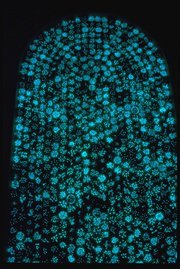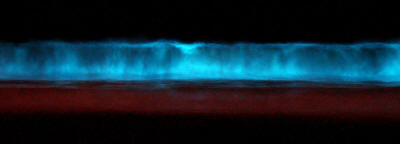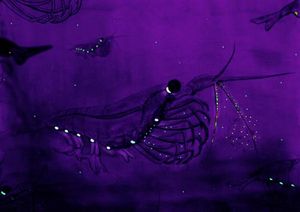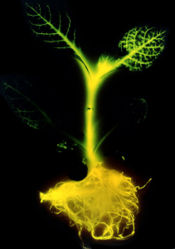
Bioluminescence is the production and emission of light by a living organism as the result of a chemical reaction during which chemical energy is converted to light energy. The name originates from the Greek bios for "living" and the Latin lumen "light". Bioluminescence may be generated by symbiotic organisms carried within a larger organism. It is generated by an enzyme-catalyzed chemoluminescence reaction, wherein the pigment luciferin is oxidised by the enzyme luciferase. Adenosine triphosphate (ATP) is involved in most instances. The chemical reaction can occur either within or outside of the cell. In bacteria, the expression of genes related to bioluminescence is controlled by an operon called the lux operon.
Contents |
Characteristics of the phenomenon

Bioluminescence is a form of luminescence, or "cold light" emission; less than 20% of the light generates thermal radiation. It should not be confused with fluorescence, phosphorescence or refraction of light.
Ninety percent of deep-sea marine life is estimated to produce bioluminescence in one form or another. Most marine light-emission belongs in the blue and green light spectrum, the wavelengths that can transmit through water most easily. However, certain loose jawed fish emit red and infrared light.
Non-marine bioluminescence is less widely distributed, but a larger variety in colours is seen. The two best-known forms of land bioluminescence are fireflies and New Zealand glow worms. Other insects, insect larvae, annelids, arachnids and even species of fungi have been noted to possess bioluminescent abilities.
Most forms of bioluminescence are lighter (or only exist) at night, following a circadian rhythm.

Adaptations for bioluminescence
There are four main accepted theories for the evolution of bioluminescent traits:
- Camouflage
- Attraction
- Repulsion
- Communication
Attraction
Bioluminescence is used as a lure to attract prey by several deep sea fish such as the anglerfish. A dangling appendage that extends from the head of the fish attracts small animals to within striking distance of the fish. Some fish, however, utilize a non-bioluminescent lure.
The cookiecutter shark uses bioluminescence for camouflage, but a small patch on its underbelly remains dark and appears as a small fish to large predatory fish like tuna and mackerel. When these fish try to consume the "small fish", they are bitten by the shark.
Dinoflagellates have an interesting twist on this mechanism. When a predator of plankton is sensed through motion in the water, the dinoflagellate luminesces. This in turn attracts even larger predators which will consume the would-be predator of the dinoflagellate.
The attraction of mates is another proposed mechanism of bioluminescent action. This is seen actively in fireflies who utilize periodic flashing in their abdomens to attract mates in the mating season. In the marine environment this has only been well-documented in certain small crustacean called ostracod. It has been suggested that pheromones may be used for long-distance communication, and bioluminescent used at close range to "home in" on the target.
The honey mushroom attracts insects using bioluminescence, hoping the insects will help disseminate the fungus' spores into the environment.
Repulsion
Certain squid and small crustaceans utilize bioluminescent chemical mixtures, or bioluminescent bacterial slurries in the same way as many squid use ink. A cloud of luminescence is expulsed, confusing or repelling a potential predator while the squid or crustacean escapes to safety.
Communication
Bioluminescence is thought to play a direct role in communication between bacteria. It promotes the symbiotic induction of bacteria into host species, and may play a role in colony aggregation.
Biotechnology

Bioluminescent organisms are a target for many areas of research. Luciferase systems are widely used in the field of genetic engineering as reporter genes (see picture left). Luciferase systems have also been harnessed for biomedical research using bioluminescence imaging.
Vibrio symbiosis with numerous marine invertebrates and fish, namely the Hawaiian bobtail squid (Euprymna scolopes) is a key experimental model for symbiosis, quorum sensing, and bioluminescence.
The structure of photophores, the light producing organs in bioluminescent organisms, are being investigated by industrial designers.
Some proposed applications of engineered bioluminescence include:
- Christmas trees that don't need lights, reducing dangerous electronics
- glowing trees to line highways to save government electricity bills
- agricultural crops and domestic plants that luminesce when they need watering
- new methods for detecting bacterial contamination of meats and other foods
- bio-identifiers for escaped convicts and mental patients
- detecting bacterial species in suspicious corpses
- novelty pets that bioluminesce (rabbits, mice, fish etc.)
Organisms that bioluminesce
All cells produce some form of bioluminescence within the electromagnetic spectrum, but most is neither visible nor noticeable to the naked eye. Every organism's bioluminescence is unique in wavelength, duration, timing and regularity of flashes. Below follows a list of organisms which have been observed to have visible bioluminescence.
Non-marine organisms
- certain
arthropods
- fireflies
-
glow worms
- railroad worms
- certain mycetophilid flies
certain centipedes
certain millipedes
- annelids
-
Mushrooms (see Foxfire)
- Jack O'Lantern mushroom
Honey mushroom
Panellus stipticus
several species of Mycena
- Jack O'Lantern mushroom
Fish
- cookie cutter shark
Marine hatchetfish
Anglerfish
Flashlight fish
Pineconefish
Porichthys
Beebe's monster
Gulper Eel
Marine invertebrates
- many
cnidarians
- Sea pens
coral
Aequorea victoria, a jellyfish
- Sea pens
- Ctenophores or "comb jellies"
certain echinoderms
certain nudibranchs
certain clams - certain
crustaceans
- ostracods
krill
- ostracods
- certain
Octopuses
- Bolitaenidae
- certain
squid
- the order Teuthida
Colossal Squid
Mastigoteuthidae
Sepiolidae
Firefly squid
- the order Teuthida
Plankton and microbes
- Dinoflagellates
Vibrionaceae (e.g. Vibrio fischeri, Vibrio harveyi, Vibrio phosphoreum)
External links
- Bioluminescence web page
- Lights Alive! at San Diego Natural History Museum
- Glow in the Dark Shark has Killer Smudge article describing cookie cutter shark adaptation
- Glowing & Luminous Fungi Algae and Fireflies: A collection of references to Bioluminescence




 216.73.216.81
216.73.216.81 User Stats:
User Stats:
 Today: 0
Today: 0 Yesterday: 0
Yesterday: 0 This Month: 0
This Month: 0 This Year: 0
This Year: 0 Total Users: 117
Total Users: 117 New Members:
New Members:
 216.73.xxx.xx
216.73.xxx.xx
 Server Time:
Server Time: